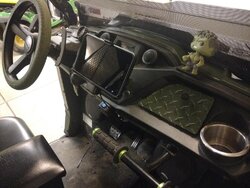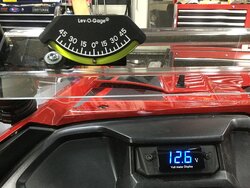View attachment 109953
Here is a diagram to help folks understand the relationship between more ground clearance say with taller tires and how it affects the tipping angle. My 2018 P5 had a sticker saying the tipping angle is 33.5 degrees. My calculations in the attached diagram indicate the center of gravity is about 38 inches above grade or about 3 inches above the rack. Since most of the mass of the P5 is below the rack, the center of gravity they used is obviously including people and cargo. One can use the diagram and examples to work out their own situation. I was interested in taller tires giving 2 inches of additional clearance. For those not sure about the math, Tan is short for tangent of an angle which is simply the side opposite the angle divided by the adjacent side. Most calculators have this function so it isn’t as scary as it Looks for the math. I also used a rounded 50 inch width so x=25 inches.....it is a bit less than that for the rear tires in reality. One can also use the diagram to calculate the new roll over angle if one does not elect to use a wider stance with spacers or offset wheels.
I've been lurking for some time, as long as the BBS website would allow. Now I own a P-500. I appreciate your trying to show tip angle and how to figure it out. I have to say, it's a bit obtuse.
Also, You've said there's a sticker on the machine stating a tipping angle. Mine's a 2015 model. I haven't found any such sticker, where is it? I also haven't found anything like that in the the official dealer's maintenance manual or the owner's manual.
I've also discovered a big difference in perceived stability depending on tire pressure. I wonder how any sticker that makes an absolute claim can account for that.
Regarding aftermarket inclinometers, I'm dubious, have been for years. Most are simply plum-bobs in bearings. Electronically, so are those in smart-phones, where accelerometers are used.
Where can I find an accurate system that I can rely on? Also, what math can I rely on? Someone says tip angle for a stock P-500 is a shave more than 33 degrees. What does that mean in the real world?
On area trails that I would find mild on my (very long gone, stolen, in fact) Yamaha Tri-Moto 125 easily ridden, in winter on my snowmobile, laughably easy, I sweat bullets trying not to let my geriatric father hit the dirt coming 'round a left-hand bend. It can't be all that bad, it just feels that way. Mostly I expect it's because the P-500 is relatively tall and narrow, and I can't lean into the turn. I'd like to have hard data.
BTW, I have the original OEM option plastic roof. With it, my P-500 is just shorter than my Father's 3/4 Chevy truck, a bit taller than my old Ford pick-up, and about the height of my FJ-55 Land Cruiser on 30.5" tires. I never felt afraid of rolling my beloved FJ-55. It's 68" wide, I guess that's the difference (I imagine the center of gravity must be much higher than the P-500).



